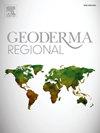Diversification, age, and organic amendments affect microbial and enzymatic activities in soils of Arabica coffee plantations in the tropical lowlands of Colombia
IF 3.3
2区 农林科学
Q2 SOIL SCIENCE
引用次数: 0
Abstract
Coffee cultivation is essential for tropical agriculture and rural livelihoods in Latin America, Africa, and Asia. However, coffee production in tropical low-altitude regions characterized by acidic soils and elevated temperatures faces significant challenges, and the soil microbiological dynamics under these environments remain poorly understood. This study assessed the impact of agricultural practices and edaphoclimatic variables on soil biological indicators, such as enzymatic activities and basal respiration in coffee fields located below 1000 m altitude in Colombia. Surveys conducted with 40 coffee growers characterized various agronomic practices and socioeconomic factors, and 150 soil samples were collected from their coffee crops of differing ages and associated species. Enzymatic activities were measured using specific substrates, including acid and alkaline phosphatase, arylsulfatase, urease, dehydrogenase, and β-glucosidase. Statistical analyses including constrained ordination, Spearman correlations, and mixed models, were employed to evaluate variations in biological indicators concerning agronomic practices and edaphoclimatic conditions.
Four groups of coffee growers were identified based on their management practices. Livestock-focused growers who utilized organic fertilizers exhibited the highest enzymatic activity, with measurements of acid phosphatase at 365 μg g−1 h−1, alkaline phosphatase at 49 μg g−1 h−1, and arylsulfatase at 137 μg g−1 h−1. In contrast, traditional growers with older plantations recorded the lowest acid phosphatase (215 μg g−1 h−1), alkaline phosphatase (36 μg g−1 h−1), and β-glucosidase (30 μg g−1 h−1). Basal soil respiration was significantly higher in shade-grown coffee compared to sun-grown (43.0 and 12.6 mg CO2–C kg−1 soil d−1, respectively). Coffee intercropping with Musaceae, Cocoa, and Inga species, organic fertilization, and liming enhanced soil biological indicators.
多样化、年龄和有机修正影响哥伦比亚热带低地阿拉比卡咖啡种植园土壤中的微生物和酶活性
咖啡种植对拉丁美洲、非洲和亚洲的热带农业和农村生计至关重要。然而,以酸性土壤和高温为特征的热带低海拔地区的咖啡生产面临着重大挑战,并且这些环境下的土壤微生物动力学仍然知之甚少。本研究评估了农业实践和土壤气候变量对哥伦比亚海拔1000米以下咖啡田土壤生物指标(如酶活性和基础呼吸)的影响。对40名咖啡种植者进行了调查,描述了各种农艺实践和社会经济因素,并从他们不同年龄和相关物种的咖啡作物中收集了150个土壤样本。酶活性测定使用特定底物,包括酸性和碱性磷酸酶,芳基磺化酶,脲酶,脱氢酶和β-葡萄糖苷酶。统计分析包括约束排序、Spearman相关和混合模型,用于评估与农艺实践和气候条件有关的生物指标的变化。根据咖啡种植者的管理实践,确定了四组咖啡种植者。使用有机肥的家畜养殖户表现出最高的酶活性,酸性磷酸酶为365 μg−1 h−1,碱性磷酸酶为49 μg−1 h−1,芳基磺化酶为137 μg−1 h−1。相比之下,种植年限较长的传统种植者的酸性磷酸酶(215 μg−1 h−1)、碱性磷酸酶(36 μg−1 h−1)和β-葡萄糖苷酶(30 μg−1 h−1)最低。遮荫咖啡的基础土壤呼吸显著高于日光咖啡(分别为43.0和12.6 mg CO2-C kg - 1土壤d - 1)。咖啡与Musaceae, Cocoa和Inga种间作,有机施肥和石灰处理提高了土壤生物指标。
本文章由计算机程序翻译,如有差异,请以英文原文为准。
求助全文
约1分钟内获得全文
求助全文
来源期刊

Geoderma Regional
Agricultural and Biological Sciences-Soil Science
CiteScore
6.10
自引率
7.30%
发文量
122
审稿时长
76 days
期刊介绍:
Global issues require studies and solutions on national and regional levels. Geoderma Regional focuses on studies that increase understanding and advance our scientific knowledge of soils in all regions of the world. The journal embraces every aspect of soil science and welcomes reviews of regional progress.
 求助内容:
求助内容: 应助结果提醒方式:
应助结果提醒方式:


